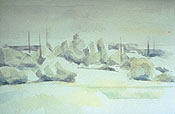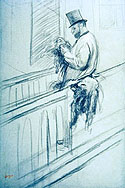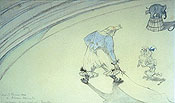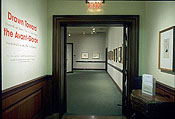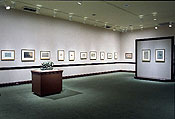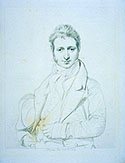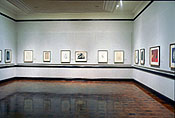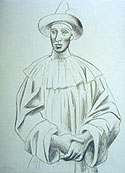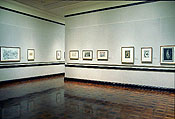The browser will either open the file, download it, or display a dialog.
|
"Drawn Toward the Avant-Garde: Nineteenth- and Twentieth-Century French Drawings from the Royal Museum of Fine Arts, Copenhagen" Jan Wurtz Frandsen, with a foreword by Allis Helleland and Chris Fischer |
||||||
|
The last few years have seen a remarkable number of drawings exhibitions, many focusing on the nineteenth century and some exclusively on France. Among these are the Muriel Butkin Collection from the Cleveland Museum of Art; Greuze the Draftsman organized by the Frick Collection, New York, and the J. Paul Getty Museum, Los Angeles; The Thaw Collection: Acquisitions since 1994 at The Pierpont Morgan Library, New York; and French Nineteenth-Century Drawings in the Robert Lehman Collection, organized on the occasion of the publication of the latest in the series of catalogues for the Lehman collection at The Metropolitan Museum of Art. |
|||||
| Drawn Toward the Avant-Garde was the last in a series of three drawings exhibitions hosted by the Frick Art and Historical Center in Pittsburgh. The first two were Masterworks from the Albertina: Renaissance to Rococo and Rubens, Jordaens, Van Dyck and Their Circle: Flemish Master Drawings from the Museum Boijmans Van Beuningen. Above all, the Frick must be lauded for its efforts to put together a considered exhibition schedule, one that examines an issue—in this case, drawing—in full. Such a strategy assumes an intelligent and mature audience with an attention span adequate to the task of sustained study. Moreover, this kind of programming demonstrates the museum administration's acceptance of its mandate to educate its visitors rather than just to entertain them. Interest in drawings exhibitions is difficult to maintain; to have done three such shows in a row over the course of a year takes the kind of courage that is often sorely lacking in museums these days. | ||||||
| Having said that, Drawn Toward the Avant-Garde was a relatively weak conclusion to an otherwise stellar, year-long exhibition program at the Frick. The individual works are beautiful and worthy of careful scrutiny. There are masterpieces by familiar artists, such as Manet, Degas, Cézanne, Morisot, Gauguin, Pissarro, Toulouse-Lautrec, Matisse, and Picasso (figs. 1–3), as well as some intriguing surprises among the holdings in Copenhagen. A strong thesis for the show, however, is wanting. The exhibition tries to survey nineteenth- and twentieth-century French art history, a presumptuous attempt considering the gaps in the Danish collection. There are no examples by David, Géricault, Gros or Guérin; nothing by any of the academic artists, such as Gérôme, Bouguereau or Baudry; no works by Couture, Gleyre, Fantin-Latour, Flandrin, Delaroche, Courbet or Seurat, all of whom are recognized for their draftsmanship. The authors of the catalogue admit these lacunae, and there is a perfectly legitimate reason for them that sheds light on the interesting subject of the history of collecting. But rather than making a virtue out of the idiosyncrasies of the collection, the organizers ignored them. Instead, they embraced a modernist narrative that is all too familiar and none too critical. Furthermore, there is no compelling reason to repeat the story of the inevitable march towards modernism exclusively with drawings. It is not made clear either in the exhibition catalogue, or in the hanging of the show, how drawings, as opposed to paintings, sculpture or decorative arts, contribute to our understanding of modernism. We learn nothing new about modernism; we learn a little about drawing in nineteenth-century France. | ||||||
| In Pittsburgh, the exhibition opened with Jean-Louis Forain's Portrait of the Cabaret Singer Valéry Roumy (ca. 1880) and Pierre Bonnard's The Shadow (ca. 1942) (fig. 4). Both are intriguing if diminutive and unassuming works, which fail to illustrate the curators' stated intentions to trace the development of modernism. Beyond the entrance to the exhibition, the drawings were lined up in a row, evenly spaced, on neutral off-white walls: a cliché that reinforces the modernist paradigm as a strictly formal enterprise. | ||||||
|
|
||||||
| Arranged chronologically, the first room of the exhibition held drawings from the early part of the nineteenth century and rehearsed the litany of styles: neoclassicism, romanticism, realism, impressionism (fig. 5). Ingres's Portrait of the Vedute Painter and Lithographer Jean-Charles Chrysostome Pecharman, Baron de Vèze greets the spectator (fig. 6). The crisp contours, stippled modeling in the face, and the scumbling in the hair demonstrate the range of effects than can be achieved with the hard, sharp point of a pencil. This section was particularly strong in works from the Barbizon School with examples by Jean-François Millet, Émile Jacque, and Constant Troyon. Rousseau is well represented with two chalk and one ink drawing that show the range of his skills. A Small Group of Tall Trees in the Macherin Forest is notable for the artist's sensual handling of the medium and his sensitivity to the quality of the paper. | ||||||
| The drawings by sculptors are a particularly surprising and a welcome addition to the grouping. Jean-Baptiste Carpeaux's oil sketch The Blast Furnaces at St.-Vast-là-haut near Valenciennes is a stunning and provocative study of place and a stark contrast to the more harmonious and, in some ways, naïve approach to landscape adopted by Barbizon artists. Its inky black ground licked with yellow and orange tongues of paint belie the sculptor's reputation for frivolity and superficiality. Frandsen explains in the entry that Carpeaux considered his paintings a highly personal undertaking and almost never exhibited them. They remained unknown—and therefore were without impact—until twenty years after his death in 1875 when they came on the market (pp. 78–79). One can hardly trace the development of a movement with examples, beautiful though they are, that virtually no one saw. Nevertheless, this is an intriguing aspect of Carpeaux's personality and working process that warrants further investigation, and this visitor applauds the organizers' decision to introduce this rarely seen material to the public. | ||||||
| In the next rooms, the sheets by Claude-Émile Schuffenecker and Othon Friesz were equally striking, the former for his impressionist color harmonies and the latter for his lyrical gestures with pen, pencil or brush. The Royal Museum of Fine Arts holds 119 drawings by Friesz dating to 1903 through 1915 and focusing on the artist's Fauve period from 1906–09. The collection was donated by Johannes Rump, who had the foresight to keep detailed inventories. These, too, were given to the museum and are published for the first time as appendices in the catalogue. This information provides valuable insight, not only about the artist and his working process, but also about the history of taste and collecting. | ||||||
| After the requisite sheets by Picasso, Matisse, and Giacometti, the exhibition closed rather predictably with abstract works by Victor Vasarely and a few lesser-known artists, such as Félix del Marle, Serge Poliakoff, and Maurice Estève (figs. 7, 8, 9). | ||||||
| The first essay in the catalogue describes the history of the collection in Copenhagen, identifying major donors and tracing acquisitions over the years. Frandsen admits the collection is not comprehensive in terms of modernism—no collection can ever be so—but attempts no explanation of its unique character. What were the interests of the major donors? What were their motivations? Were they typical of other European collectors of the period? In the next essay, the author addresses the issue of modernity by invoking Baudelaire and providing a survey of "isms" from 1800 through 1950. It is neither profound nor insightful. The catalogue is lavishly illustrated with photographs that give a good idea of paper color and quality and accurately communicate the texture of the medium. The objects are thoroughly researched and closely observed in the individual entries. | ||||||
| Several years ago, a well-known scholar at a conference chided her colleagues working in museums for imposing their simplistic interpretations of works of art on the public in the name of "education." "Just give me the pictures," she said, "and I'll interpret them myself." I think of this every time I visit the National Gallery of Art in Washington, D.C., where there is a rotating installation of Small French Paintings. No one has attempted to suggest a narrative for the pictures. There are no labels, no text panels other than those crediting the donors (Ailsa Mellon Bruce and Mr. and Mrs. Paul Mellon). People are free to make any associations they want—or none at all. This seems to me to be a truly open-ended dialogue between the works and the visitor, providing the visitor knows something about art history. The curator is all but invisible. | ||||||
| Such a strategy is not always desirable, especially in the area of the graphic arts where there is still so much to learn about media, technique, and the market. In an effort to appeal to a diverse audience, the organizers relied on the old standby of the theme of modernism to make the Danish collection relevant to an American audience. They opted not to ask the hard questions about the definition of "modernity" or even its significance to the production and consumption of art during this period. But whatever Drawn Toward the Avant-Garde may lack in critical analysis and interpretation, it more than makes up for in selection. | ||||||
| Cheryl K. Snay Research Associate, Nineteenth-Century French Drawings Project The Baltimore Museum of Art / The Walters Art Museum |
||||||


